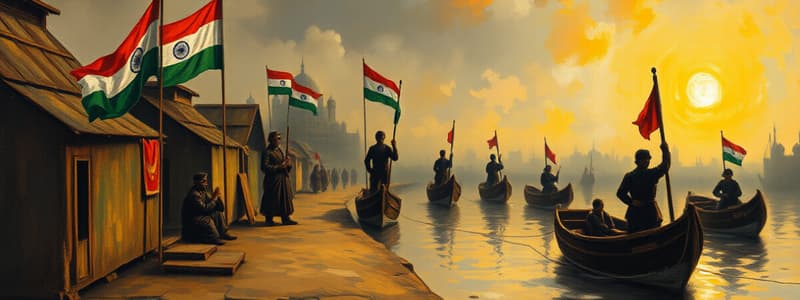Podcast
Questions and Answers
What was a significant outcome of the First World War on India?
What was a significant outcome of the First World War on India?
- Increased taxation and forced recruitment (correct)
- Improved economic stability
- Strengthened British governance in India
- Increased British military presence
The Non-Cooperation Movement aimed to encourage cooperation with the British government.
The Non-Cooperation Movement aimed to encourage cooperation with the British government.
False (B)
What was the primary goal of the Khilafat Movement?
What was the primary goal of the Khilafat Movement?
To protect the position of the Ottoman Sultan as Caliph
The desire for self-governance during the British colonial rule in India is known as ______.
The desire for self-governance during the British colonial rule in India is known as ______.
Match the following movements with their primary objectives:
Match the following movements with their primary objectives:
Which leader played a significant role in the Non-Cooperation Movement?
Which leader played a significant role in the Non-Cooperation Movement?
The Khilafat Movement was primarily a Hindu initiative.
The Khilafat Movement was primarily a Hindu initiative.
What event led to widespread disillusionment among Indians regarding British promises?
What event led to widespread disillusionment among Indians regarding British promises?
Which group was NOT primarily involved in the Non-Cooperation Movement in urban areas?
Which group was NOT primarily involved in the Non-Cooperation Movement in urban areas?
The Salt March was a significant act of civil disobedience that started in 1930.
The Salt March was a significant act of civil disobedience that started in 1930.
What was the primary demand of plantation workers during the movement?
What was the primary demand of plantation workers during the movement?
Peasants in Awadh and Andhra Pradesh refused to pay ______ as a form of protest.
Peasants in Awadh and Andhra Pradesh refused to pay ______ as a form of protest.
Match the following regions/groups with their primary grievances:
Match the following regions/groups with their primary grievances:
What was promoted as a symbol of self-reliance during the Non-Cooperation Movement?
What was promoted as a symbol of self-reliance during the Non-Cooperation Movement?
The Civil Disobedience Movement faced no significant limitations.
The Civil Disobedience Movement faced no significant limitations.
What act did Gandhi's Salt March directly challenge?
What act did Gandhi's Salt March directly challenge?
Flashcards are hidden until you start studying
Study Notes
Nationalism in India
- Emerged as a reaction to British colonial rule, focused on self-governance and independence.
- Unified diverse communities around the common goal of freeing India from foreign domination.
- Significant events and leaders were instrumental in developing national consciousness, culminating in India’s independence in 1947.
The First World War, Khilafat, and Non-Cooperation
-
Impact of the First World War (1914-1918): Strained British economy, leading to increased taxation and forced recruitment in India.
-
Promises of political reforms made to Indians in exchange for support during the war were largely unfulfilled, resulting in widespread disillusionment.
-
Economic hardships and political dissatisfaction after the war stimulated the growth of nationalism.
-
Khilafat Movement:
- Launched by Indian Muslims to protest the disintegration of the Ottoman Caliphate post-war.
- Aimed to protect the Ottoman Sultan's position as Caliph, a key spiritual leader for Muslims globally.
- Gandhi promoted the Khilafat issue as a means to unite Hindus and Muslims against British colonial rule.
-
Non-Cooperation Movement (1920-1922):
- A mass protest led by Gandhi, encouraging Indians to withdraw cooperation from the British government.
- Advocated for boycotting British goods, institutions, and honors, emphasizing swadeshi (indigenous) products.
- Aimed to create a climate of non-cooperation, complicating British governance.
Differing Strands Within the Movement
-
Urban Participation:
- In cities, significant involvement from students, lawyers, and traders characterized the Non-Cooperation Movement.
- Boycotts targeted educational institutions, courts, and foreign goods, fostering the use of khadi as a symbol of resistance.
-
Rural Agitation:
- Addressed grievances of peasants and tribals against high taxation, forced labor, and oppressive landlords.
- In regions like Awadh and Andhra Pradesh, peasants organized meetings and refused to pay taxes.
- Protests modelled non-violent resistance, but instances of violent rebellion occurred.
-
Plantations and 'Swaraj':
- Spread among plantation workers in Assam, highlighting harsh working conditions and movement restrictions.
- Workers protested low wages and the Inland Emigration Act that limited their mobility, demanding 'Swaraj' or self-rule.
Towards Civil Disobedience
-
Salt March and Civil Disobedience Movement (1930):
- Gandhi’s Salt March spanned 240 miles from Sabarmati to Dandi, challenging the British monopoly on salt.
- This act of civil disobedience encouraged widespread defiance of British laws through self-production of salt.
- The movement expanded to encompass boycotts of British goods and refusal to pay taxes.
-
Participants' Perspectives:
- Included a diverse array of social groups: women, students, peasants, and industrial workers.
- Motivated by social justice, economic relief, and a sense of national pride, fostering collective identity and empowerment.
-
Limits of Civil Disobedience:
- The movement encountered challenges, including internal divisions within the Indian National Congress.
- Repressive measures from the British government hindered the movement's effectiveness.
Studying That Suits You
Use AI to generate personalized quizzes and flashcards to suit your learning preferences.



